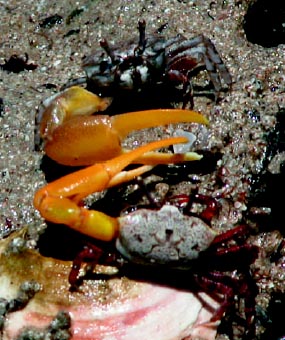How tall is too tall? For the fiddler crab (Uca mjoebergi), a simple change in elevation can dramatically override a female’s preference for a male, as a new study by researchers at the Australian National University shows.
Male fiddler crabs signal their quality to females by waving their large claw back and forth. Waves that reach higher points in a female’s field of vision are considered more attractive. Crabs with larger claws can perform taller waves. Males will also straighten their legs in order to raise their claws higher. However, males that are too high up might be perceived as predators instead of potential mates. What if a male were waving from the top of a small hill?
Researchers Luke Holman, Andrew Khan, and Patricia Backwell tested the idea that if a male stands on elevated ground, a female’s preference for him will be significantly influenced.
Experiments
The study consisted of two experiments, and utilized robotic crabs, or “robocrabs”, instead of live males (robot models allow researchers to control variables such as wave rate and claw size more precisely). A quick check confirmed that females would approach a single robocrab and perform courtship displays by tapping on it.
The first experiment assessed the joint effects of claw size and elevation. Females were given a choice between two robocrabs; one at her level on one side, and one on a slight incline on the other side. The robocrab on the incline had a claw that was either the same size, larger, or smaller than that of the non-elevated robocrab.
The second experiment looked at the joint effects of wave rate and elevation. The elevated robocrab waved either twice as frequently or half as frequently as the non-elevated robocrab.
Results
Holman and Khan found that in both experiments, females overwhelmingly preferred robocrabs at their level to robocrabs on higher ground, even when the elevated robocrabs had faster wave rates or larger claws.
The conclusion was that in areas where the elevation is not constant, even males with small claws and low wave rates have a chance of attracting females. Although previous studies have demonstrated that large claws and fast waves are attractive, this study shows that elevation does indeed profoundly affect female preference.
As females recognized a single elevated male as a potential mate, it was unclear why this same male was considered so unattractive compared to a non-elevated male. Perhaps elevated burrows are unfavorable in temperature stability or humidity, and future studies could explore this.
This study is a startling reminder that as important as it is to control experiments, it is would be narrow-minded to assume that what is observed in the lab will hold true in nature. It also shows that the very same selective pressures (claw size and wave rate) can have wildly differing outcomes based on an organism’s environment (flat vs hilly).
Holman, L., Khan, A.T. and Backwell, P.R.Y. 2014. Fiddlers on the roof: elevation muddles mate choice in fiddler crabs. Behavioral Ecology 21(2): 271-275.


